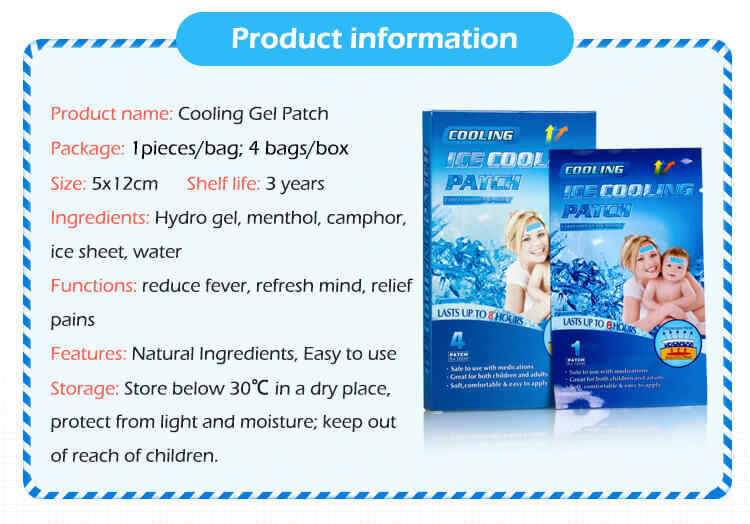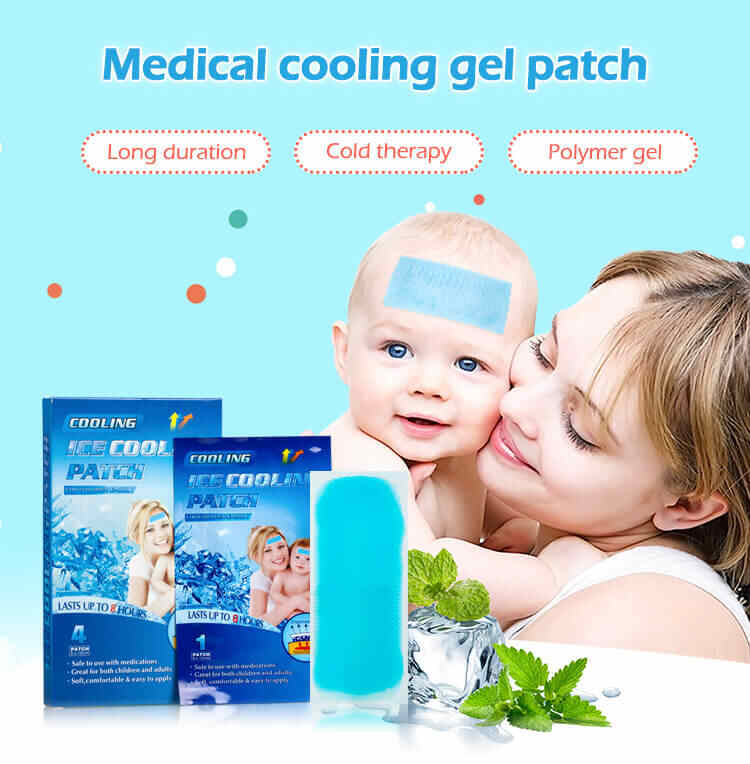What Certifications Should a Fever Cooling Patch OEM Have?
As the global demand for over-the-counter (OTC) wellness products continues to grow, fever cooling patches have become increasingly popular among health-conscious consumers. These patches offer fast, non-invasive relief and are especially favored for children, the elderly, and those sensitive to oral medications. But for a brand planning to enter this market, the real challenge lies not only in the product itself, but also in finding a compliant and capable fever cooling patch OEM partner.
One of the most critical aspects of choosing the right fever cooling patch manufacturer is evaluating their certifications. These certifications are not just legal checkboxes—they are indicators of quality, safety, trustworthiness, and global market readiness.
In this article, we’ll discuss the essential certifications every reputable fever cooling patch OEM should have, why these certifications matter, and how they can empower your brand, whether you're developing a Custom fever cooling patch, launching a Private Label fever cooling patch, or sourcing products from a fever cooling patch supplier.
1. Why Certifications Are Critical in OEM Manufacturing
Choosing a certified fev

er cooling patch manufacturer ensures your product meets regulatory standards in both domestic and international markets. Certifications guarantee:
Consumer safety
Product consistency
Regulatory approval
Brand credibility
Global market access
Without these certifications, your Private Label fever cooling patch may be blocked at customs, recalled from stores, or face legal challenges—damaging both your business and brand reputation.
2. Core Certifications a Fever Cooling Patch OEM Must Have
Let’s explore the most important certifications you should look for when selecting a fever cooling patch OEM or supplier:
2.1 GMP (Good Manufacturing Practice)
Why it matters:
GMP ensures that the product is manufactured in a controlled and hygienic environment. It focuses on production consistency, quality control, and risk mitigation.
What it covers:
Personnel training and hygiene
Equipment validation
Raw material sourcing and tracking
Quality assurance protocols
Batch record-keeping
Impact on your business:
Choosing a GMP-certified fever cooling patch OEM gives you confidence that the products will be safe, effective, and compliant with global quality standards.
2.2 ISO 13485: Medical Device Quality Management
Why it matters:
This certification is specifically tailored for the medical device industry. Fever cooling patches are often classified as medical devices or Class I products in many markets.
What it covers:
Risk management
Document control
Product lifecycle monitoring
Post-market feedback systems
Impact on your business:
An ISO 13485-certified fever cooling patch manufacturer is more likely to pass audits and comply with global regulations, making your product market-ready for countries like the U.S., Canada, EU nations, Japan, and more.
2.3 CE Marking (European Conformity)
Why it matters:
A product with CE marking meets all applicable EU safety, health, and environmental protection standards.
What it covers:
Product testing and validation
Technical documentation
Clinical evaluation (when applicable)
Declaration of conformity
Impact on your business:
If you’re targeting the European market, working with a fever cooling patch OEM that provides CE-marked products ensures smooth market entry and consumer trust.
2.4 FDA Registration (U.S. Food and Drug Administration)
Why it matters:
To legally sell fever cooling patches in the United States, your OEM must be registered with the FDA, especially if the product is classified as an OTC drug or medical device.
What it covers:
Facility registration
Product listing
Adherence to FDA labeling requirements
Post-market surveillance compliance
Impact on your business:
Partnering with an FDA-compliant fever cooling patch manufacturer minimizes the risk of non-compliance, delays, or penalties in the lucrative U.S. market.
2.5 MSDS (Material Safety Data Sheet)
Why it matters:
MSDS provides detailed safety information on ingredients used in the Custom fever cooling patch.
What it covers:
Chemical composition
Toxicology and allergen information
First aid measures
Storage and handling instructions
Impact on your business:
It helps demonstrate the safety of your ingredients to both regulators and consumers—critical for e-commerce and export compliance.
2.6 COA (Certificate of Analysis)
Why it matters:
COAs validate that a batch of fever cooling patches meets required specifications.
What it covers:
Microbiological test results
Physical property tests (e.g., adhesion, temperature response)
Shelf-life validation
Impact on your business:
COAs are often required by retailers and regulatory bodies. A compliant fever cooling patch supplier should provide COAs for every batch.
2.7 Other Regional Certifications
Depending on your target markets, additional certifications may be required:
NMPA (China): For domestic sale in China
KFDA (South Korea): Korean compliance for medical products
TGA (Australia): Therapeutic Goods Administration for wellness products
HALAL / Vegan / Cruelty-Free: For niche consumer segments
Choosing a globally aware fever cooling patch OEM ensures you’re prepared for expansion into diverse markets.
3. How Certifications Impact Your Brand and Sales Strategy
The right certifications are more than regulatory requirements—they are strategic assets. Here's how:
3.1 Faster Market Entry
Working with a certified fever cooling patch manufacturer shortens approval times with customs, online platforms (like Amazon), and global retail partners.
3.2 Higher Retail Confidence
Retailers and distributors are more likely to work with certified products because they reduce the risk of recalls or liability.
3.3 Stronger Consumer Trust
Consumers look for visible trust signals—like “FDA Registered” or “CE Certified”—on packaging. This is especially important for Private Label fever cooling patches that need instant credibility.
3.4 Brand Differentiation
In a saturated market, promoting your adherence to global standards helps distinguish your product from lower-quality or non-compliant alternatives.
4. What to Ask Your Fever Cooling Patch OEM About Certifications
When evaluating a fever cooling patch OEM, ask:
Can you provide current copies of your GMP and ISO certificates?
Are your products FDA registered and CE marked?
Do you offer COA and MSDS with each batch?
Can you assist with regulatory documentation for international markets?
Have your products passed any dermatological or sensitivity tests?
A professional fever cooling patch supplier will answer these confidently and offer documented proof.
5. Certifications and Customization: Do They Work Together?
Yes—certifications do not limit your ability to customize.
You can still create a Custom fever cooling patch with unique formulations, designs, or packaging while staying compliant. A skilled fever cooling patch OEM will:
Help develop your product in line with GMP/ISO standards
Conduct ingredient safety testing
Ensure your Private Label fever cooling patch meets target-market requirements
This allows you to launch a differentiated, innovative product without sacrificing safety or compliance.
6. Summary: Certifications as a Competitive Advantage
In today’s competitive healthcare product market, compliance is not optional—it’s essential. Certifications are your foundation for:
Legal market access
Consumer safety and satisfaction
Global expansion readiness
Retail and e-commerce platform listing
Stronger brand equity
By partnering with a fully certified fever cooling patch OEM, you're not only reducing risk—you’re enhancing your chances of long-term success.
Whether you're creating a Custom fever cooling patch, launching a Private Label fever cooling patch, or sourcing wholesale from a fever cooling patch supplier, certifications are a non-negotiable component of your business strategy.
Related Questions & Short Answers
Q1: What’s the most important certification for a fever cooling patch OEM?
A: GMP is the foundational certification ensuring quality manufacturing. ISO 13485, FDA registration, and CE marking are also critical depending on your market.
Q2: Can I sell a Private Label fever cooling patch without certifications?
A: Not legally. Most countries require that medical or wellness products meet regulatory standards before entering the market.
Q3: How do I verify a fever cooling patch manufacturer's certifications?
A: Ask for digital copies and check that they are issued by recognized bodies. You can also validate FDA registration through the FDA’s public database.
Q4: Do certifications limit product customization?
A: No. Certified fever cooling patch OEMs allow full customization while maintaining compliance through guided development and testing.
Q5: What documents should a compliant fever cooling patch supplier provide?
A: COA, MSDS, product specifications, ingredient lists, labeling support, and relevant certificates.
Q6: Is CE marking necessary for online sales in the EU?
A: Yes. CE certification is legally required for OTC medical devices sold in the European Union, including e-commerce.
Q7: Are certifications different for child-safe fever cooling patches?
A: Child-use products may require additional safety or dermatological testing. A quality fever cooling patch manufacturer will support this.






